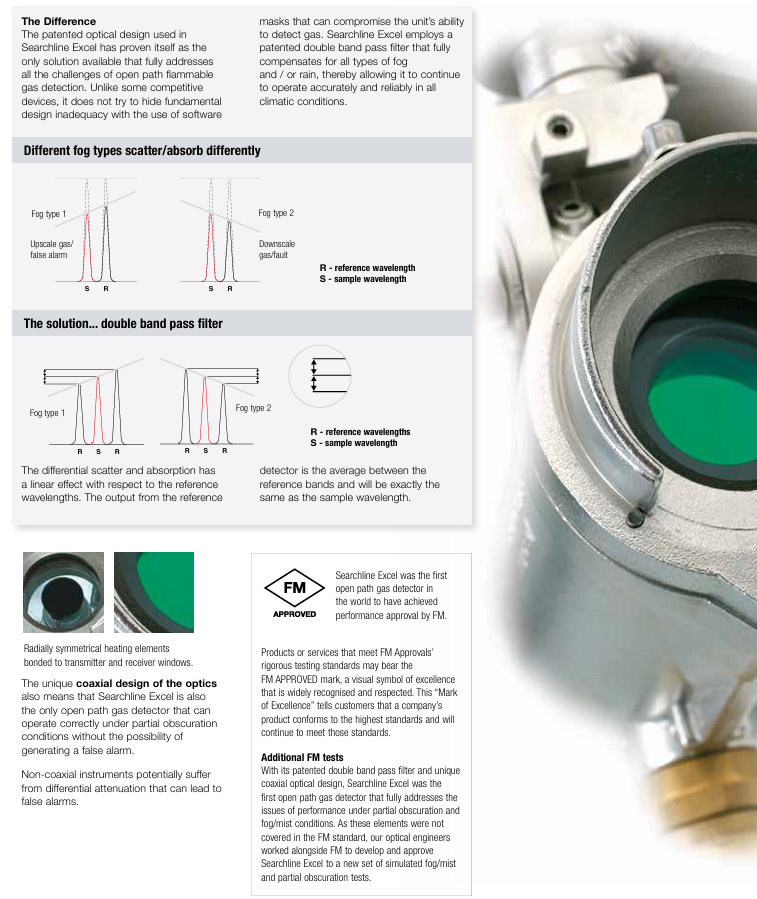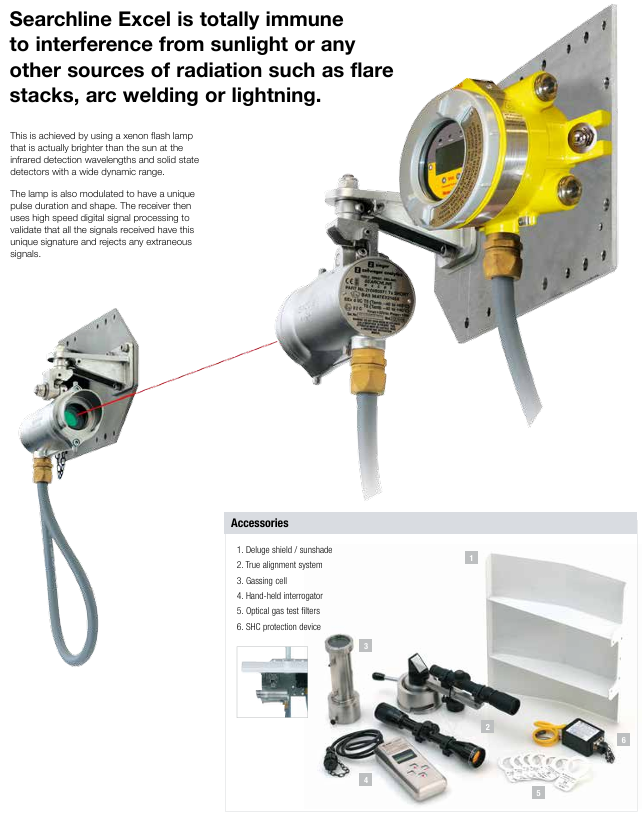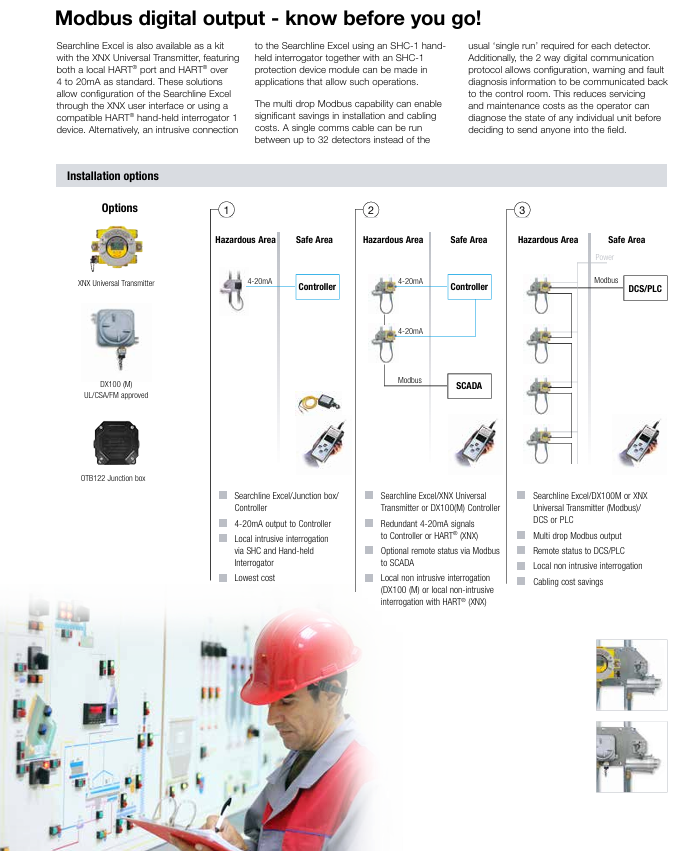

K-WANG


Honeywell Searchline Excel Infrared Open Circuit Gas Detector
Industry benchmark: In 1987, Honeywell first launched the first generation Searchline open circuit infrared combustible gas detector. After upgrading to Searchline Excel in 1998, it became the industry standard in the field of open circuit gas detection with performance that meets and exceeds customer needs. It is often paired with Searchpoint Optima Plus point detectors as the main combustible gas detection solution.
Honeywell Searchline Excel Infrared Open Circuit Gas Detector
Product positioning and market position
Core positioning: A globally leading infrared open circuit combustible gas detector with over 25000 units installed as of document release. It is widely used in various harsh industrial environments, deployed from the Arctic Circle to the Middle East desert, and is the preferred product for many customers.
Industry benchmark: In 1987, Honeywell first launched the first generation Searchline open circuit infrared combustible gas detector. After upgrading to Searchline Excel in 1998, it became the industry standard in the field of open circuit gas detection with performance that meets and exceeds customer needs. It is often paired with Searchpoint Optima Plus point detectors as the main combustible gas detection solution.
Core application scenarios
Suitable for industrial scenarios with high requirements for combustible gas detection, including:
Offshore platforms and vessels (such as floating production storage and offloading units FPSO)
Downstream chemical processing plants
Natural gas transportation and pipeline system
Large storage areas and factories
Perimeter detection scenario

Core features and advantages of the product
1. Environmental adaptability and reliability
Climate compensation: Using patented dual bandpass filters, it can fully compensate for various weather disturbances such as fog, rain, and mist, ensuring accurate detection under different climate conditions; Simultaneously possessing 100% resistance to light interference, avoiding the influence of sunlight on the detection results.
Endurance to harsh environments: Radial symmetrical and bonded window heating design ensures stable performance in low-temperature environments; High vibration resistance (2-60Hz, maximum peak to peak amplitude 1mm), suitable for industrial equipment vibration scenarios; The shell is made of 316 stainless steel material, with a protection level of IP66 and IP67, and is dustproof and waterproof.
Partial occlusion compatibility: The coaxial optical design is unique to the industry and can work normally when detecting partial occlusion in the path without the risk of false alarms; Similar products with non coaxial designs are prone to false alarms due to differential attenuation.
2. Performance and efficiency testing
High sensitivity and fast response: The detection range is 0-5 LEL · m (lower explosive limit · m), with a recommended low alarm threshold of 1.0 LEL · m and a high alarm threshold of 3.0 LEL · m. The response speed is fast, with T90 (time to reach 90% of the detection value) less than 3 seconds (under normal operating conditions).
Wide coverage and precise positioning: Supports three path lengths - short (5-40m), medium (40-120m), and long (120-200m). A single device can cover a wider area, reducing the deployment requirements of multi-point detectors; Can indicate the size of the danger zone and help staff quickly determine the risk range.
3. Installation and maintenance convenience
Easy calibration and alignment: equipped with a "locked" alignment tool and high-power, high magnification telescope, the alignment operation is simple and accurate, without the need for additional "software alignment" steps; The True Alignment system can achieve high-precision alignment without the need for subsequent software adjustments.
Low power consumption and convenient monitoring: Low power consumption under all operating conditions (maximum 3.5-5.0W for short-range transmitters, maximum 10-13W for medium and long-range transmitters, and maximum 8W for receivers); Optional Modbus RS485 multi station output, supporting 32 detectors sharing one communication cable, significantly reducing installation and wiring costs; By using XNX universal transmitter or SHC-1 handheld interrogator, local/remote configuration, status monitoring, and fault diagnosis can be achieved, reducing on-site maintenance frequency.
4. Safety certification and compliance
Obtained FM (Factory Mutual) hazardous area certification and performance certification, making it the world's first open circuit gas detector to pass FM performance certification; It also complies with multiple international safety standards such as ATEX, UL, CSA, and is suitable for Class I hazardous areas (such as Class 1 Div 1/Zone 1).
Additional customized testing through FM: Honeywell engineers collaborate with FM to develop specialized simulation tests for scenarios not covered by FM standards such as "partial occlusion" and "fog/mist" to further validate product performance.

Advantages of open circuit gas detection technology (compared to point type detectors)
As a supplementary solution to point detectors, open circuit detectors have the following irreplaceable advantages:
The reliability of the detection has been verified through practical applications, reducing the risk of missed detections (for example, point detectors may miss pipeline leaks, while open circuit detectors can accurately capture them)
Covering a wider area makes it easier to detect leakage points at any location
The response speed is much higher than that of point detectors
Fault safety design: No unexposed fault modes, no problem of detector gas path blockage
The installation position requirements for detectors are lower, and there is no need to strictly align with potential leakage points
Easy installation and debugging, can replace multiple point detectors, and reduce overall deployment costs
Technical specifications and parameters
Category specific parameters
Detect gases such as methane, ethane, propane, butane, pentane, ethylene, propylene, and butadiene
Path length: Short distance: 5-40m; Medium distance: 40-120m; Long distance: 120-200m
Output signal 4-20mA (maximum loop resistance 600 Ω, supports source/drain output); RS485; 21mA over range, 2-3mA fault signal (user programmable)
Digital output needs to be paired with DX100 (M) or XNX universal transmitter with Modbus option, supporting Modbus RS485 multi station output
Environmental parameters: Operating humidity: 0-99% RH (non condensing); Work pressure: 91.5-105.5kPa (without pressure compensation)
Power supply and power consumption: 18-32VDC; Power consumption: Short range Tx 3.5-5.0W, medium to long range Tx 10-13W, Rx 8W (all maximum values)
Physical specifications and weight (including installation bracket): Short distance Tx 3.5kg, medium to long distance Tx 7kg, Rx 3.5kg; Alignment tolerance ± 0.5 °
Certification and Standard Performance Certification: FM; Safety Certification: ATEX, UL, CSA, GOST; EMC standard: EN50270
Preheating time ready:<5 minutes; Completely stable:<1 hour
Installation configuration and accessories
1. Installation options
Support multiple installation combinations for hazardous and safe areas, adapting to different control systems. Common solutions include:
Searchline Excel+DX100 (M) (UL/CSA/FM certified)+Controller/DCS/PLC
Searchline Excel+junction box (such as OTB122)+controller
Searchline Excel+XNX universal transmitter+controller/DCS/PLC (supports redundant 4-20mA signal, HART protocol)
Multi station Modbus output: Connect 32 detectors with a single cable to reduce wiring costs and support bidirectional digital communication (configuration, alarm, fault diagnosis)
2. Core accessories and functions
XNX universal transmitter: provides local display and supports HART ®、 Modbus、 Foundation Fieldbus ™) Waiting for interfaces to enhance compatibility between devices and control systems
SHC-1 handheld interrogator: equipped with a protection module, it can perform local invasive configuration and diagnosis of the detector in allowed scenarios
Telescope installation mechanism: a unique three-point installation benchmark ensures alignment accuracy; The perspective can be adjusted to the most convenient position without the need for subsequent software adjustments

- YOKOGAWA
- Energy Access
- Renewable Integration
- Energy Subsidies
- Energy and Water
- Net zero emission
- Energy Security
- Critical Minerals
- A-B
- petroleum
- Mine scale
- Energy and Gender
- Covid-19
- man-machine
- Reliance
- ADVANCED
- SEW
- ProSoft
- WATLOW
- Kongsberg
- FANUC
- VSD
- DCS
- PLC
- Sewage treatment
- cement
- Yaskawa
- Woodward
- BOSCH Rexroth
- MOOG
- General Electric
- American NI
- Rolls-Royce
- CTI
- Honeywell
- EMERSON
- Automobile market
- xYCOM
- Motorola
- architecture
- Industrial information
- New energy
- electricity
- Construction site
- HIMA
- ABB
- Rockwell
- Schneider Modicon
- Siemens
- MAN
- GE
- TRICONEX
- Control Wave
- ALSTOM
- AMAT
- STUDER
- KONGSBERG
- MOTOROLA
- DANAHER MOTION
- Bentley
- Galil
- EATON
- MOLEX
- Triconex
- DEIF
- B&W
- ZYGO
- Aerotech
- DANFOSS
- KOLLMORGEN
- Beijer
- Endress+Hauser
- schneider
- Foxboro
- KB
- REXROTH
- YAMAHA
- Johnson
- Westinghouse
- WAGO
- TOSHIBA
- TEKTRONIX
- BENDER
- BMCM
- SMC
- HITACHI
- HIRSCHMANN
-
BENTLY NEVADA 3500/15 133292-01 Power Supply Module
-
ABB PM877 3BDH000777R1 Central_Unit Controller
-
GE Hydran M2-X Enhanced Monitoring
-
ABB REG316 1mrk000809-GA Numerical Generator Protection
-
ABB RED670 1MRK004810 Line differential protection
-
GE SR750-P5-G5-S5-HI-A20-R-E Feeder protection system
-
ABB PFTL301E-1.0KN 3BSE019050R1000 PillowBlock Load cells
-
Kollmorgen S33GNNA-RNNM-00 - Brushless Servo Motor
-
Kollmorgen 6sm56-s3000-g-s3-1325 - Servo Motor
-
Kollmorgen AKM52K-CCCN2-00 - Servo Motor
-
Kollmorgen PSR3-230/75-21-202 - Power Supply
-
Kollmorgen akm24d-anc2r-00 - Servo Motor
-
Kollmorgen AKM22E-ANCNR-00 - Servo Motor
-
Kollmorgen S60300-550 - Servo Drive
-
Kollmorgen B-204-B-21 - Servomotor
-
Kollmorgen AKM21E-BNBN1-00 - Servo Motor
-
Kollmorgen TT2953-1010-B - DC Servo Motor
-
Kollmorgen pa8500 - Servo Power Supply
-
Kollmorgen BDS4A-210J-0001-207C2 - Servo Drive
-
Kollmorgen TTRB1-4234-3064-AA - DC Servo Motor
-
Kollmorgen MH-827-A-43 - Servo Motor
-
Kollmorgen AKM24D-ACBNR-OO - Servo Motor
-
Kollmorgen 00-01207-002 - Servo Disk DC Motor
-
Kollmorgen AKM21C-ANBNAB-00 - Servo Motor
-
Kollmorgen PSR3-208/50-01-003 - Power Supply
-
Kollmorgen 6SM56-S3000 - Servo Motor
-
Kollmorgen DBL3H00130-B3M-000-S40 - Servo Motor
-
Kollmorgen 6SN37L-4000 - Servo Motor
-
Kollmorgen AKM65K-ACCNR-00 - Servo motor
-
Kollmorgen 6SM56-L3000-G - Servo Motor
-
Kollmorgen AKMH43H-CCCNRE5K - Servo Motor
-
Kollmorgen PSR4/52858300 - Power Supply
-
Kollmorgen KBM-79H03-E03 - Direct Drive Rotary Motor
-
Kollmorgen AKM33E-ANCNDA00 - Servo Motor
-
Kollmorgen U9M4/9FA4T/M23 - ServoDisc DC Motor
-
Kollmorgen AKM13C-ANCNR-00 - Servo Motor
-
Kollmorgen AKM43L-ACD2CA00 - Servo Motor
-
Kollmorgen AKM54K-CCCN2-00 - Servo Motor
-
Kollmorgen M-605-B-B1-B3 - Servo Motor
-
Kollmorgen AKD-P00606-NBAN-0000 - Rotary Drive
-
Kollmorgen 6SM-37M-6.000 - Servo Motor
-
Kollmorgen A.F.031.5 - Sercos Interface Board
-
Kollmorgen 918974 5054 - Servo PWM
-
Kollmorgen U12M4 - ServoDisc DC Motor
-
Kollmorgen AKD-B00606-NBAN-0000 - Servo Drive
-
Kollmorgen MV65WKS-CE310/22PB - Servo Drive
-
Kollmorgen 65WKS-CE310/22PB - Servo Drive
-
Kollmorgen EM10-27 - Module
-
Kollmorgen S64001 - Servo Drive
-
Kollmorgen CR03200-000000 - Servo Drive
-
Kollmorgen 6SM57M-3000+G - Servo Motor
-
Kollmorgen BDS4 - Servo Drive
-
Kollmorgen AKD-P00306-NBEC-000 - Servo Drive
-
Kollmorgen AKD-B01206-NBAN-0000 - Servo Drive
-
Kollmorgen STP-57D301 - Stepper Motor
-
Kollmorgen 6SM37L-4.000 - Servo Motor
-
Kollmorgen 44-10193-001 - Circuit Board
-
Kollmorgen PRDR9SP24SHA-12 - Board
-
Kollmorgen PRD-AMPE25EA-00 - Servo Drive
-
Kollmorgen DBL3N00130-0R2-000-S40 - Servo Motor
-
Kollmorgen S406BA-SE - Servo Drive
-
Kollmorgen AKD-P00607-NBEI-0000 - Servo Drive
-
Kollmorgen AKD-P01207-NBEC-0000 - Servo Drive
-
Kollmorgen CR03550 - Servo Drive
-
Kollmorgen VSA24-0012/1804J-20-042E - Servo Drive
-
Kollmorgen N2-AKM23D-B2C-10L-5B-4-MF1-FT1E-C0 - Actuator
-
Kollmorgen 04S-M60/12-PB - Servo Drive
-
Kollmorgen H33NLHP-LNW-NS50 - Stepper Motor
-
Kollmorgen A-78771 - Interlock Board
-
Kollmorgen AKM43E-SSSSS-06 - Servo Motor
-
Kollmorgen AKD-P00607-NBEC-0000 - Servo Drive
-
Kollmorgen E21NCHT-LNN-NS-00 - Stepper Motor
-
Kollmorgen cr10704 - Servo Drive
-
Kollmorgen d101a-93-1215-001 - Motor
-
Kollmorgen BDS4A-203J-0001-EB202B21P - Servo Drive
-
Kollmorgen MCSS23-6432-002 - Connector
-
Kollmorgen AKD-P01207-NACC-D065 - Servo Drive
-
Kollmorgen CK-S200-IP-AC-TB - I/O Adapter and Connector
-
Kollmorgen CR10260 - Servo Drive
-
Kollmorgen EC3-AKM42G-C2R-70-04A-200-MP2-FC2-C0 - Actuator
-
Kollmorgen BDS5A-206-01010-205B2-030 - Servo Drive
-
Kollmorgen s2350-vts - Servo Drive
-
Kollmorgen AKM24D-ANC2DB-00 - Servo Motor
-
Kollmorgen E31NCHT-LNN-NS-01 - Stepper Motor
-
Kollmorgen PRD-0051AMPF-Y0 - Servo Board
-
Kollmorgen TB03500 - Module
-
Kollmorgen 60WKS-M240/06-PB - Servo Drive
-
Kollmorgen M21NRXC-LNN-NS-00 - Stepper Motor
-
Kollmorgen H-344H-0212 - Servo Motor
-
Kollmorgen MCSS08-3232-001 - Connector
-
Kollmorgen AKM33H-ANCNC-00 - Servo Motor
-
Kollmorgen PA-2800 - Power Supply
-
Kollmorgen MTC308C1-R1C1 - Servo Motor
-
Kollmorgen PRDR0091300Z-00 - Capacitor Board
-
Kollmorgen BDS4A-206J-0024/01502D79 - Servo Drive
-
Kollmorgen S20330-VTS - Servo Drive
-
Kollmorgen S20250-CNS - Servo Drive
-
Kollmorgen SBD2-20-1105-WO - Servo Drive Board
-
Kollmorgen M405-C-A1--E1 - Servo Motor
-
Kollmorgen PRD-PB805EDD-00 - Servo Drive
-
Kollmorgen 6SM57S-3.000-J-09-HA-IN - Servo Motor
-
Kollmorgen AKM33H-ANCNDA-00 - Servo Motor
-
Kollmorgen PCB-00030200-04 - PCB
-
Kollmorgen H22SSLB-LNN-NS-02 - Stepper Motor
-
Kollmorgen BJRL-20012-110001 - Module
-
Kollmorgen BDS4A-206J-0001404A - Servo Drive
-
Kollmorgen H-342-H-0802 - Servo Motor
-
Kollmorgen CR10561 - Servo Drive
-
Kollmorgen BDS5A-206-00010-205B2-030 - Servo Drive
-
Kollmorgen BDS5A-206-00010-207B-2-030 - Servo Drive
-
Kollmorgen mcss08-3224-001 - Connector
-
Kollmorgen M-207-B-23-B3 - Servo Motor
-
Kollmorgen PRD-0041200Z-S0 - Encoder/Resolver Card
-
Kollmorgen MH-225-G-61 - Motor
-
Kollmorgen MT308B1-T1C1 - Servo Motor
-
Kollmorgen BDS4A-240J-0001604C83 - Servo Drive
-
Kollmorgen 6SM57-S-3000 - Servo Motor
-
Kollmorgen N-T31V-15-5B-6-MF3-FT1E-C251 - Actuator
-
Kollmorgen PRD-0051AMPA-X0 - Servo Board
-
Kollmorgen CF-SS-RHGE-09 - Cable
-
Kollmorgen DIGIFAS7204 - Servo Drive
-
Kollmorgen S30101-NA - Servo Drive
-
Kollmorgen DIGIFAS7201 - Servo Drive
-
Kollmorgen PRD-0051AMPA-Y0 - Servo Board
-
Kollmorgen AKM23D-EFCNC-00 - Servo Motor
-
Kollmorgen SE10000 - Servo Drive
-
Kollmorgen PSR4/5A-112-0400 - Power Supply
-
Kollmorgen AKM31H-ANCNC-01 - Servo Motor




